
Flavor Trailblazer: Jeremy Bringardner
Meticulous flavor building underpins gold-standard innovation
Flavor Trailblazer: Jeremy Bringardner
Meticulous flavor building underpins gold-standard innovation
By Katie Ayoub
March 27, 2024
By Katie Ayoub
March 27, 2024
Mendocino Farms is a fast casual known for its “fresh and fearless flavors.” With 68 locations and more openings slated for this year, the West Coast chain leads the innovation charge in wholesome salads, bowls and sandwiches. Jeremy Bringardner, corporate executive chef, is at the helm of menu development, approaching flavor building with mindful attention to the customer experience. We sat down with him to discuss how he tackles flavor innovation, industry challenges and the ever-changing consumer.
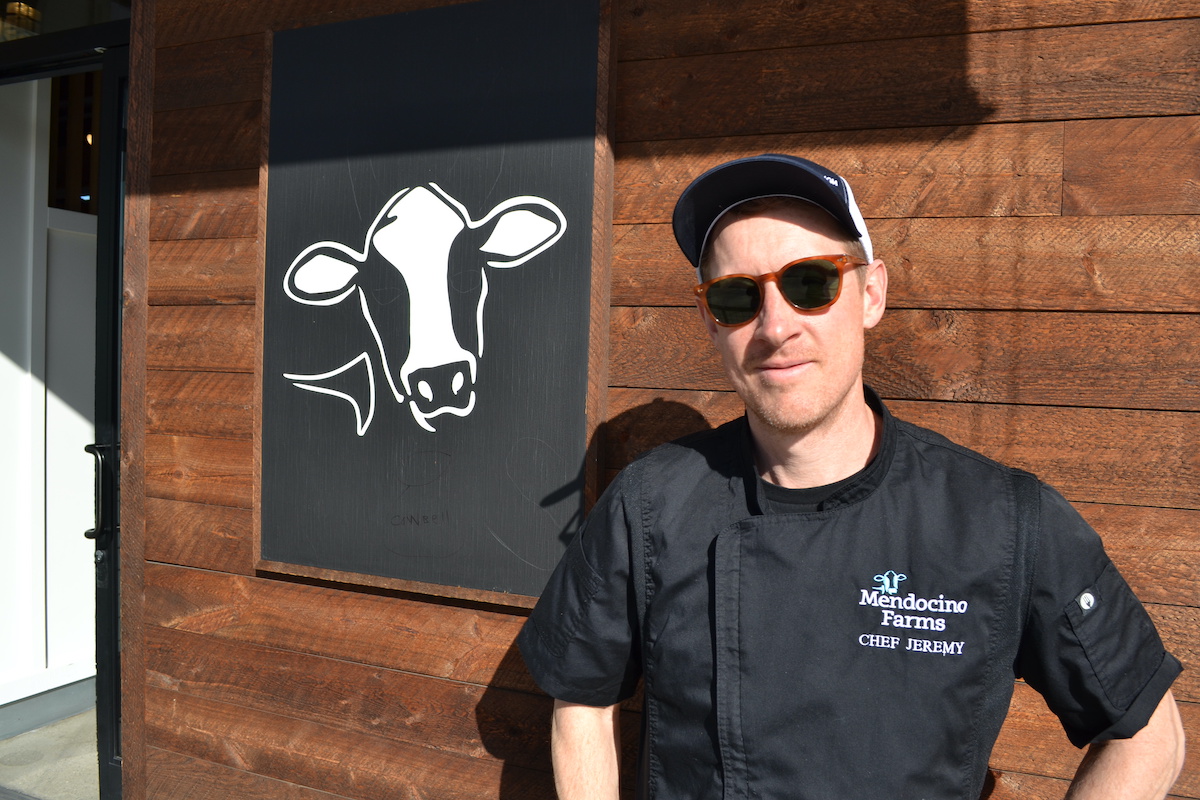
Jeremy Bringardner
Katie Ayoub: How do you describe Mendocino Farms’ core customer?
Jeremy Bringardner: Mendo guests place high value on health and well-being, quality ingredients, innovative flavors and a premium overall experience.
KA: Describe your LTO cycle.
JB: We change the menu three times per year. We used to do four cycles in sync with the seasons, but the hearty winter menu items always dropped off like a rock after the holidays, and we figured out that it was due to the shift in eating habits after New Year’s Eve. So, we combined our fall/winter into one cycle, where we feature the heartier, cold-winter-months type of comforting fare. Then we switch to the January menu after the new year and tend to feature items a bit more on the lighter/healthier side. Of course, that is followed up by our third cycle, the spring/summer menu.
KA: What’s your process for developing new builds?
JB: The process for developing new builds starts with identifying gaps in the menu and determining culinary strategies that we want to focus on. So at the beginning, I start taking in everything we know about our menu already and studying it further, considering guest feedback that we’ve gotten over the last few months to help us determine if there’s something missing on the menu or if there’s a problem in an existing recipe that needs fine tuning. For inspiration, it could be that we just got back from Flavor Experience and were inspired by a single ingredient or trend. Of course, it has to make sense for us—there’s a bit of a gut feeling to the whole ideation process.
KA: Can you give us an example of a gap in the menu that you addressed through innovation?
JB: Over a year ago, we pulled a plant-based sandwich called the Unreal Reuben off the menu. We got a ton of flack for doing that; guests wrote to us in record numbers. We had to take the sandwich off for operational and supply reasons, but with the outpouring of disappointment from our guests, we realized that we couldn’t just leave a plant-based hole on the menu. Our guests weren’t just telling us that we took off their favorite menu item, but that we didn’t have enough plant-based choices. We needed to create something really special and exciting to make our plant-based audience happy again. That became a culinary strategy that helped us create two new plant-based offerings.
KA: What did you replace the Unreal Reuben with?
JB: We came up with a new sandwich, The Happy Hippie, tested it, then got it on the menu. It’s based on that vintage health store vibe from the ’70s—lots of vegetables and lots of sprouts, with a grainy, seedy bread. We came up with one that was unique to us, but paying homage to that classic build. We gave it the “Mendo twist.” We added a beet caviar, which is roasted beets that we pulse in the blender with caramelized onion jam and a little extra-virgin olive oil. We brought it up to date and made it a little more exciting.
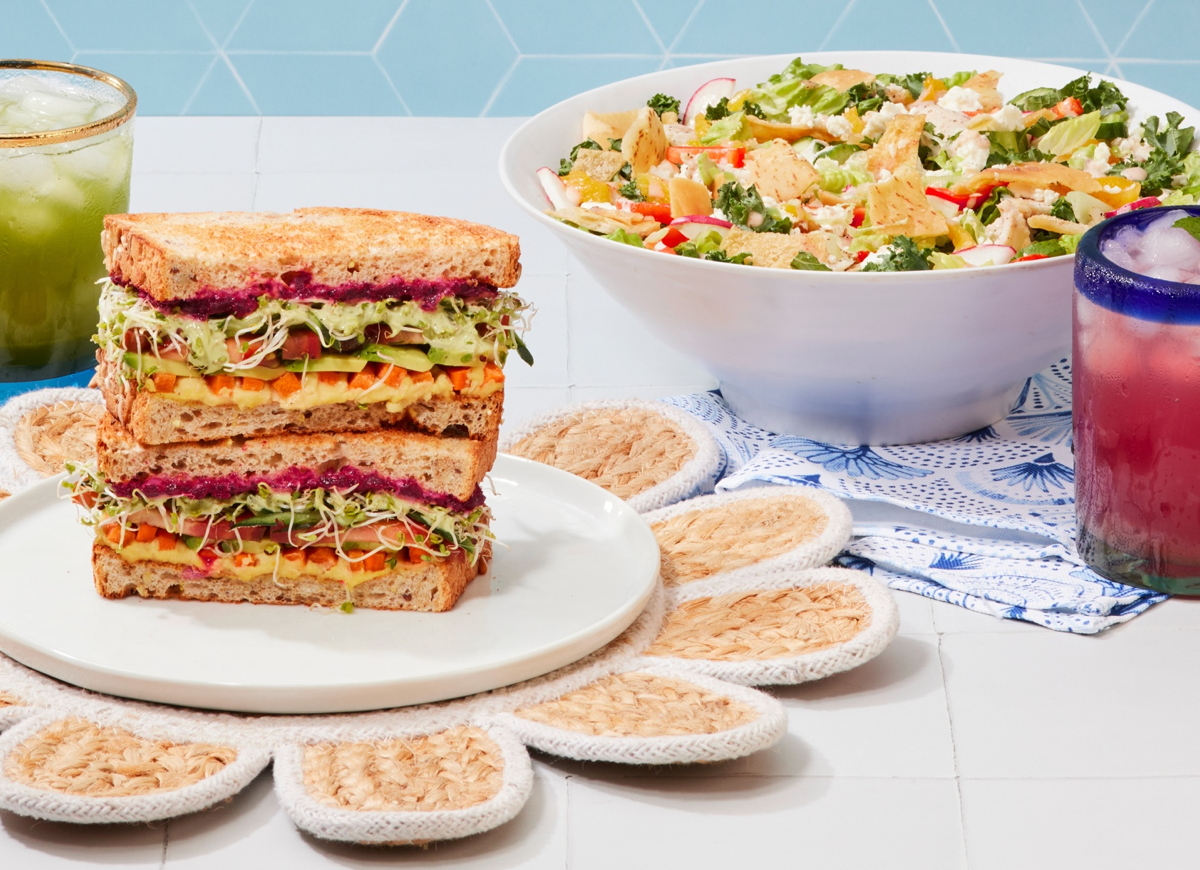 Photo Credit: Mendocino Farms
Photo Credit: Mendocino Farms The Happy Hippie answers the call for plant-forward menu options, with avocado, cucumber, carrots, Kumato tomatoes, beet caviar, sprouts, hummus, white cheddar and cucumber-dill ranch on toasted honey whole wheat.
KA: Describe the beet caviar and its role in the anatomy of the Happy Hippie Sandwich.
JB: For the beet caviar, we pulse roasted beets that are slightly pickled with a caramelized onion jam and EVOO. The jam is a little sweet, balancing out the acidity from the beets. We don’t want beets to be too beet-y—then people run away. This is a way to tame them a bit and make them delicious. And then the olive oil ensures the spreadable texture; if it’s too watery, it just soaks into the bread. That oiliness helps the spread sit on top nicely.
KA: Apart from customer feedback, how else do you identify gaps in the menu?
JB: Sometimes we’ll get excited about a specific global region, and I’ll throw myself entirely into developing those flavors. I was really inspired by Asian flavors a while back and all of a sudden, we had a whole slew of really great Asian-influenced items we’d come up with. Then we’ll realize we have to shift our focus elsewhere. I look at the menu and see gaps that have resulted in our singular focus in innovation. Currently, we’re developing a bunch of Italian- and Mediterranean-inspired items. Just as you dive into one area and you finish exploring that, it’s almost creating another gap. So you have to take another look and concentrate your efforts in a different trending region or cuisine.
KA: What made you focus on Italian and more broadly Mediterranean?
JB: We see Mediterranean trending. Cava Grill is killing it right now—love what they’re doing. We realized we had almost zero from that region and that a Med salad would be such an obvious staple, so I started working on that. We came up with the Mediterranean Crunch Salad—it did really, really well. It’s come off its run now, but we’re already talking about bringing it back.
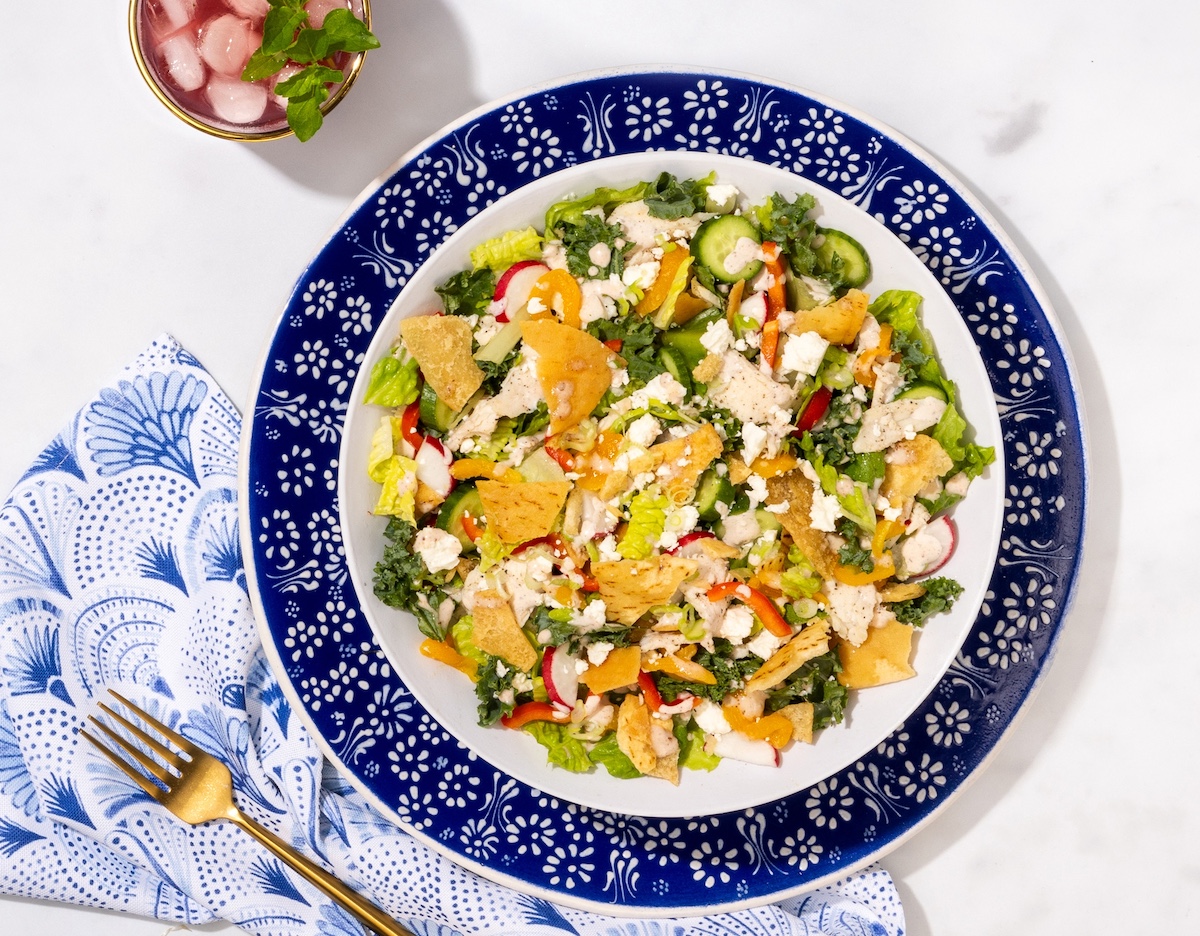 Photo Credit: Mendocino Farms
Photo Credit: Mendocino Farms The Mediterranean Crunch Salad filled a gap in the menu for Mediterranean fare, with roasted chicken breast, Persian cucumbers, apricot, red pepper, radish, feta cheese, pita chips, fresh mint, parsley, scallions, chopped romaine, curly kale and a creamy pomegranate dressing.
KA: Can you tell us about something in your innovation pipeline for 2025?
JB: In preparation for our January 2025 menu, I’ve been trying to find a way to create a healthy wrap that’s next-level delicious. Often, wraps are predictable and not particularly exciting. I think there is an opportunity to innovate in the world of wraps. So, as I set out on this mission, I knew the first thing I had to overcome was the challenge of finding a great wrapper—the vehicle. I tested all kinds of lavash and pita wraps and tortillas, but nothing really made my socks roll up and down.
The one thought that kept coming back to me was the memory of the best-tasting flour tortilla I’ve ever had. It’s made right here in Los Angeles by a Mexican family that has a successful chain of burrito joints across the city and in Mexico. Mejorado makes the most incredible little burritos and serves them out of a window in Boyle Heights. I assumed they were too small to handle our volume needs, which would be something like 10,000 tortillas per week. Much to my delight and surprise, they had actually grown their production capacity quite a lot recently and were up to the challenge. This last piece was all that was needed to complete the new wrap. It’s a veggie-forward chicken wrap that started with the most approachable Mediterranean food combo of all: hummus and chips. It gets next level with the fun, crunchy, fried pita chips, that killer Mejorado tortilla and a big-flavored sauce: the mint labneh.
KA: You’re known for your sauce innovation. Describe the mint labneh in the Chicken & Hummus Crunch Wrap.
JB: I went to great lengths to develop a craveable sauce, which really makes the whole wrap come alive. There’s a great combination of dynamic flavors: labneh, lemon juice, fresh mint leaves, garlic, grilled jalapeños, honey, pomegranate molasses and a few other ingredients.
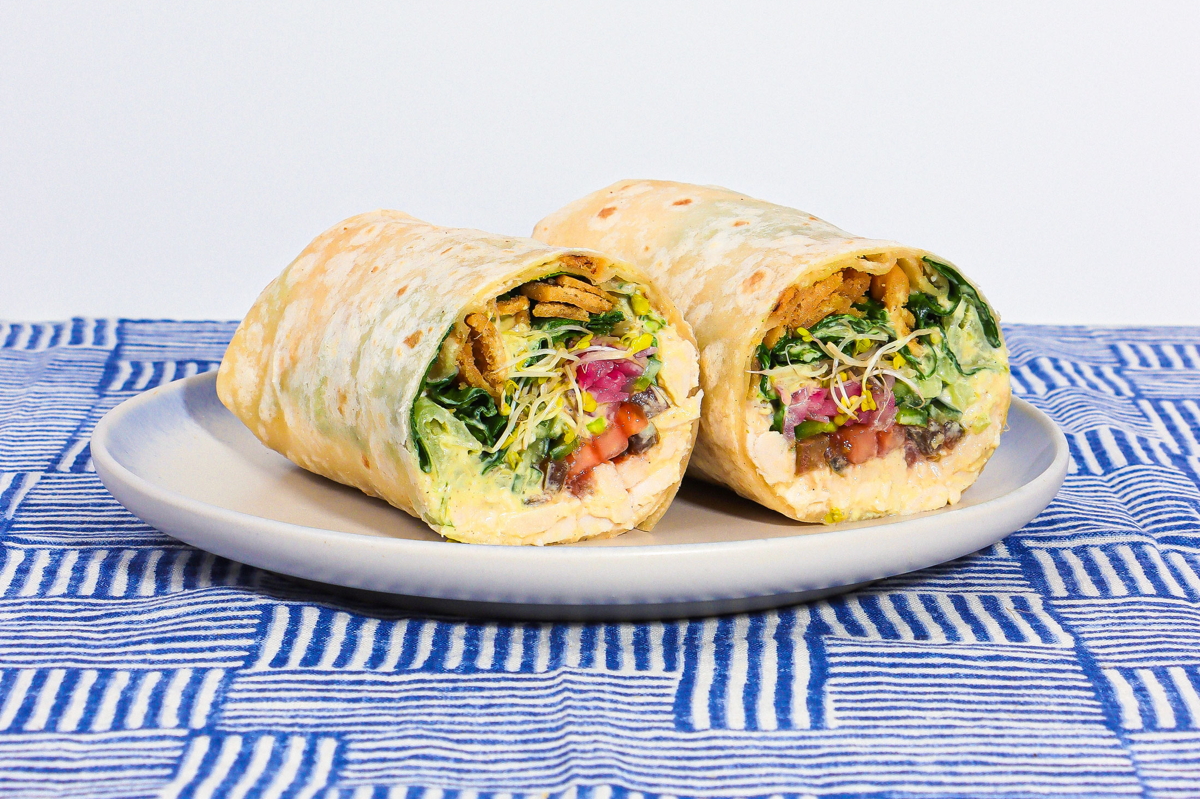
The Chicken & Hummus Crunch Wrap, currently in testing, is a Mejorado flour tortilla stuffed with roasted chicken breast, hummus, pita chips, Kumato tomatoes, cucumber, jalapeño, pickled red onion, sprouts, romaine, baby spinach, garlic spread and mint labneh.
KA: Tell us about your chef collab strategy for LTOs.
JB: The chef collab is an approach we like to take when entering a new market. It’s a great way to build community in a target market. We did a collab recently with a famous chef in the Northwest, Tom Douglas. We’ve opened two stores in Seattle, a town very familiar him. He wanted to do something with salmon in part to support a really great fishery. He pushed us to try something we’ve never done—we’ve never worked with raw fish before. We gladly accepted the challenge, and the sandwich has been a huge hit. Our Sockeye Salmon Roll is a combination of a fish taco and a sandwich that looks sort of like a lobster roll. That sandwich just killed it up there.
KA: Does its success open up more opportunities for salmon or seafood in general?
JB: Lots of guests asked if they could get the roll’s salmon in a salad build. That opened up our minds and made us think about expanding our protein options for salads and more.
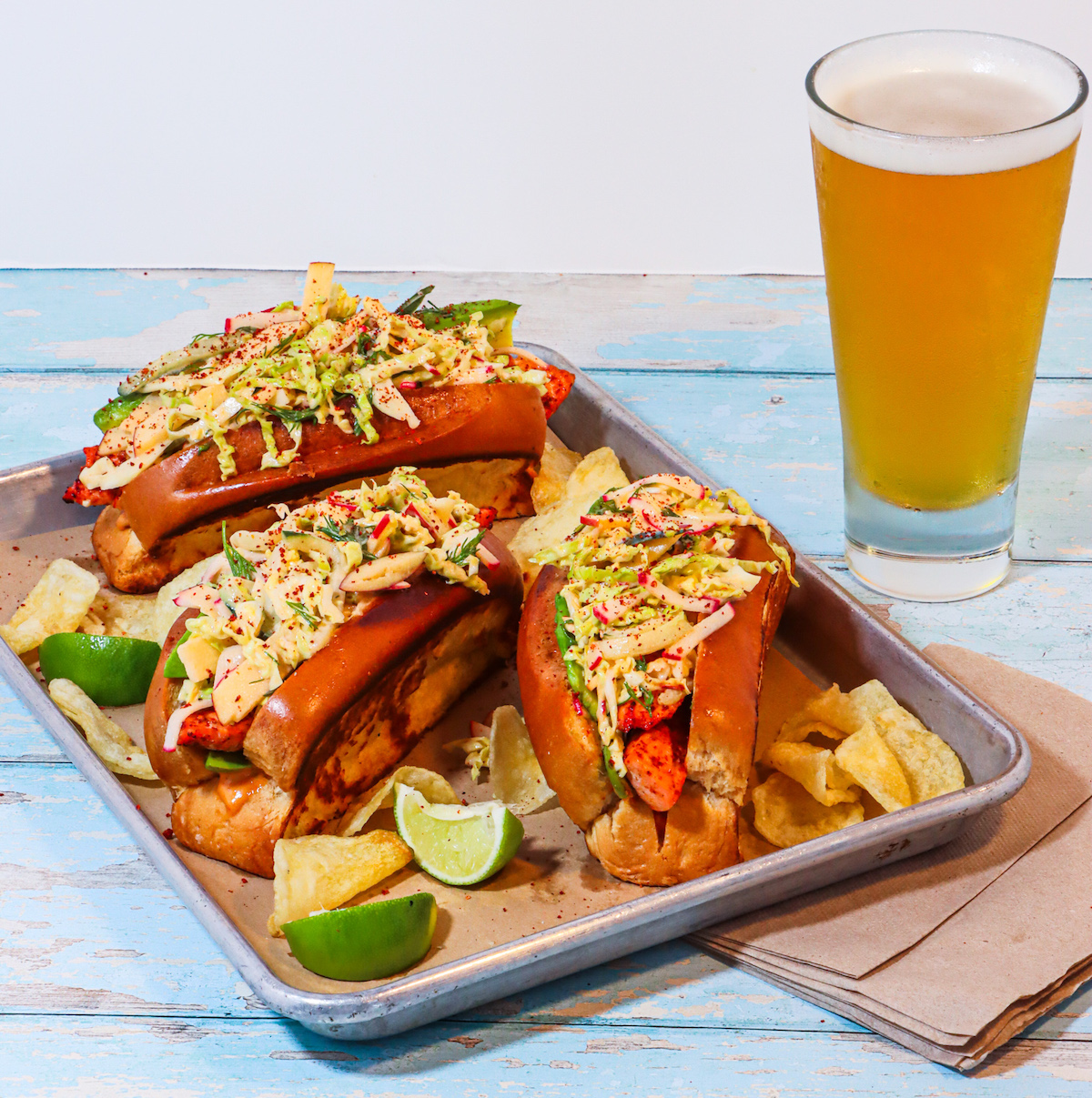 Photo Credit: Mendocino Farms
Photo Credit: Mendocino Farms The Sockeye Salmon Roll is an LTO born of a chef collab, a strategy used by Mendocino Farms when entering new markets.
KA: What’s one of your biggest challenges when innovating?
JB: Finding the right balance of approachable and adventurous. We aspire to be on the cutting edge; we want to be industry leaders. But the more out there you get, the more your audience narrows. It’s a tricky thing to find the balance between pushing the innovation but having it still be relatable. So that is, I think, an important challenge to keep in the forefront of our innovation efforts. We have to innovate to evolve and stay relevant, but where’s the line? It’s a fun one to work on.
KA: Describe an LTO or menu rollout of an item that just didn’t get the traction you thought it would.
JB: I’ll give an example of something that we’re dealing with right now. There’s a cutting-edge, new plant-based product called Fable, made mostly of shiitake mushrooms. The product does not look like a mushroom, and it hardly even tastes like a mushroom—it’s got a neutral but beefy, umami flavor. It’s so good and so interesting and solves some of our menu needs. So, we developed a sandwich called the Philly Shroomsteak. We’re not only looking to capture vegans, but also flexitarians. We wanted something as indulgent and satisfying as a Philly cheesesteak. I felt like we had something really special in this build. We launched it and sales have been pretty low—a lot lower than where we would like them to be. It’s not breaking through to the flexitarian consumer.
It’s a little frustrating because when we look at the feedback, everyone is over the moon. So back to the challenges we face: We have something that feels really cutting-edge, but now we’re struggling to find a way to just get the guests over a couple of hurdles to actually try it. We know if they taste it, they’ll come back for it. It confirms what I believe in strongly: to sample is to sell. I also think we need to downplay the Fable part of the story because it’s just too new. Use it more as an asterisk than a selling point.
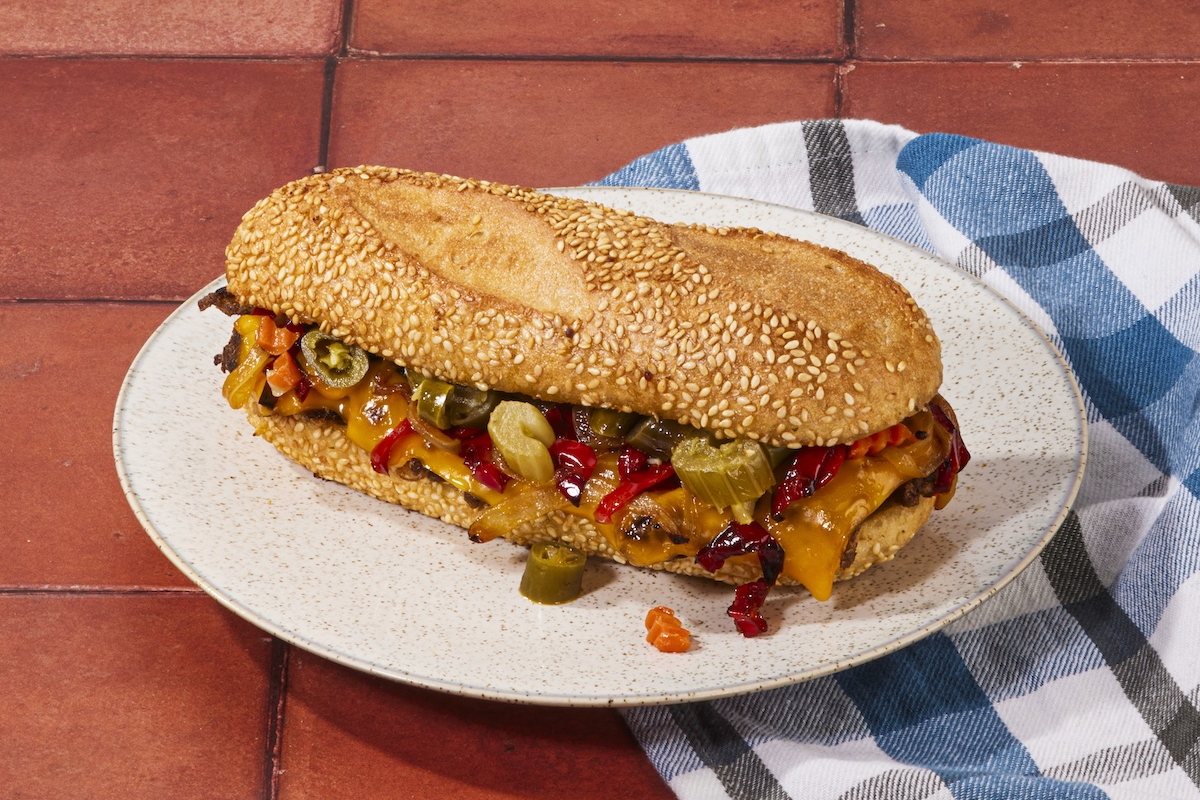 Photo Credit: Mendocino Farms
Photo Credit: Mendocino Farms The Philly Shroomsteak sandwich is a plant-forward LTO featuring shiitake “steak,” roasted red peppers and sweet onions, a choice of hot or mild giardiniera, plant-based American “cheese” and green peppercorn aïoli, served on a toasted sesame roll.
QuickFire
Something in your fridge that would surprise people:
Six different kinds of chile crisp
Cuisine you’re particularly excited to explore:
I’m dipping back into the world of Mexican and Oaxacan. I’d like to get to Mexico City as I’ve been hearing so much about the food there. I’m looking forward to exploring that region a little further to see what opportunities are there for us.
Your go-to late-night snack?
My go-to is a bowl of cereal. I combine puffed wheat with Puffins Peanut Butter cereal. Of course, as a chef, I can’t just have a cereal, but instead mix a few textures and flavors together.
Best bite you’ve had recently:
I was completely stunned by how good the French Dip à la St. Clair Supper Club was at Roister in Chicago. In a way, it’s a very simple sandwich set, yet through technique it’s brought to a level that utterly destroys every French dip I’ve ever tried, and is in fact maybe the most delicious sandwich I’ve ever eaten. They douse the bread with a high-quality extra-virgin olive oil and toast over an open fire, so it picks up a grilled, smoky flavor. They shave ribeye very thin and gently cook it on the lower shelf of the salamander, so the meat is cooked from raw to order. It’s so beefy, so meaty, so tender and juicy. Of course, there is gooey melted Swiss, perfectly caramelized onions and horseradish cream involved, but the au jus is what takes the sandwich to another universe. It’s a rich beef broth with deep-roasted mirepoix and fresh herb overtones. It tastes like something your grandma would make for Christmas dinner—if she were a Michelin-starred chef.
Mendocino Farms is a fast casual known for its “fresh and fearless flavors.” With 68 locations and more openings slated for this year, the West Coast chain leads the innovation charge in wholesome salads, bowls and sandwiches. Jeremy Bringardner, corporate executive chef, is at the helm of menu development, approaching flavor building with mindful attention to the customer experience. We sat down with him to discuss how he tackles flavor innovation, industry challenges and the ever-changing consumer.

Jeremy Bringardner
Katie Ayoub: How do you describe Mendocino Farms’ core customer?
Jeremy Bringardner: Mendo guests place high value on health and well-being, quality ingredients, innovative flavors and a premium overall experience.
KA: Describe your LTO cycle.
JB: We change the menu three times per year. We used to do four cycles in sync with the seasons, but the hearty winter menu items always dropped off like a rock after the holidays, and we figured out that it was due to the shift in eating habits after New Year’s Eve. So, we combined our fall/winter into one cycle, where we feature the heartier, cold-winter-months type of comforting fare. Then we switch to the January menu after the new year and tend to feature items a bit more on the lighter/healthier side. Of course, that is followed up by our third cycle, the spring/summer menu.
KA: What’s your process for developing new builds?
JB: The process for developing new builds starts with identifying gaps in the menu and determining culinary strategies that we want to focus on. So at the beginning, I start taking in everything we know about our menu already and studying it further, considering guest feedback that we’ve gotten over the last few months to help us determine if there’s something missing on the menu or if there’s a problem in an existing recipe that needs fine tuning. For inspiration, it could be that we just got back from Flavor Experience and were inspired by a single ingredient or trend. Of course, it has to make sense for us—there’s a bit of a gut feeling to the whole ideation process.
KA: Can you give us an example of a gap in the menu that you addressed through innovation?
JB: Over a year ago, we pulled a plant-based sandwich called the Unreal Reuben off the menu. We got a ton of flack for doing that; guests wrote to us in record numbers. We had to take the sandwich off for operational and supply reasons, but with the outpouring of disappointment from our guests, we realized that we couldn’t just leave a plant-based hole on the menu. Our guests weren’t just telling us that we took off their favorite menu item, but that we didn’t have enough plant-based choices. We needed to create something really special and exciting to make our plant-based audience happy again. That became a culinary strategy that helped us create two new plant-based offerings.
KA: What did you replace the Unreal Reuben with?
JB: We came up with a new sandwich, The Happy Hippie, tested it, then got it on the menu. It’s based on that vintage health store vibe from the ’70s—lots of vegetables and lots of sprouts, with a grainy, seedy bread. We came up with one that was unique to us, but paying homage to that classic build. We gave it the “Mendo twist.” We added a beet caviar, which is roasted beets that we pulse in the blender with caramelized onion jam and a little extra-virgin olive oil. We brought it up to date and made it a little more exciting.
 Photo Credit: Mendocino Farms
Photo Credit: Mendocino Farms The Happy Hippie answers the call for plant-forward menu options, with avocado, cucumber, carrots, Kumato tomatoes, beet caviar, sprouts, hummus, white cheddar and cucumber-dill ranch on toasted honey whole wheat.
KA: Describe the beet caviar and its role in the anatomy of the Happy Hippie Sandwich.
JB: For the beet caviar, we pulse roasted beets that are slightly pickled with a caramelized onion jam and EVOO. The jam is a little sweet, balancing out the acidity from the beets. We don’t want beets to be too beet-y—then people run away. This is a way to tame them a bit and make them delicious. And then the olive oil ensures the spreadable texture; if it’s too watery, it just soaks into the bread. That oiliness helps the spread sit on top nicely.
KA: Apart from customer feedback, how else do you identify gaps in the menu?
JB: Sometimes we’ll get excited about a specific global region, and I’ll throw myself entirely into developing those flavors. I was really inspired by Asian flavors a while back and all of a sudden, we had a whole slew of really great Asian-influenced items we’d come up with. Then we’ll realize we have to shift our focus elsewhere. I look at the menu and see gaps that have resulted in our singular focus in innovation. Currently, we’re developing a bunch of Italian- and Mediterranean-inspired items. Just as you dive into one area and you finish exploring that, it’s almost creating another gap. So you have to take another look and concentrate your efforts in a different trending region or cuisine.
KA: What made you focus on Italian and more broadly Mediterranean?
JB: We see Mediterranean trending. Cava Grill is killing it right now—love what they’re doing. We realized we had almost zero from that region and that a Med salad would be such an obvious staple, so I started working on that. We came up with the Mediterranean Crunch Salad—it did really, really well. It’s come off its run now, but we’re already talking about bringing it back.
 Photo Credit: Mendocino Farms
Photo Credit: Mendocino Farms The Mediterranean Crunch Salad filled a gap in the menu for Mediterranean fare, with roasted chicken breast, Persian cucumbers, apricot, red pepper, radish, feta cheese, pita chips, fresh mint, parsley, scallions, chopped romaine, curly kale and a creamy pomegranate dressing.
KA: Can you tell us about something in your innovation pipeline for 2025?
JB: In preparation for our January 2025 menu, I’ve been trying to find a way to create a healthy wrap that’s next-level delicious. Often, wraps are predictable and not particularly exciting. I think there is an opportunity to innovate in the world of wraps. So, as I set out on this mission, I knew the first thing I had to overcome was the challenge of finding a great wrapper—the vehicle. I tested all kinds of lavash and pita wraps and tortillas, but nothing really made my socks roll up and down.
The one thought that kept coming back to me was the memory of the best-tasting flour tortilla I’ve ever had. It’s made right here in Los Angeles by a Mexican family that has a successful chain of burrito joints across the city and in Mexico. Mejorado makes the most incredible little burritos and serves them out of a window in Boyle Heights. I assumed they were too small to handle our volume needs, which would be something like 10,000 tortillas per week. Much to my delight and surprise, they had actually grown their production capacity quite a lot recently and were up to the challenge. This last piece was all that was needed to complete the new wrap. It’s a veggie-forward chicken wrap that started with the most approachable Mediterranean food combo of all: hummus and chips. It gets next level with the fun, crunchy, fried pita chips, that killer Mejorado tortilla and a big-flavored sauce: the mint labneh.
KA: You’re known for your sauce innovation. Describe the mint labneh in the Chicken & Hummus Crunch Wrap.
JB: I went to great lengths to develop a craveable sauce, which really makes the whole wrap come alive. There’s a great combination of dynamic flavors: labneh, lemon juice, fresh mint leaves, garlic, grilled jalapeños, honey, pomegranate molasses and a few other ingredients.

The Chicken & Hummus Crunch Wrap, currently in testing, is a Mejorado flour tortilla stuffed with roasted chicken breast, hummus, pita chips, Kumato tomatoes, cucumber, jalapeño, pickled red onion, sprouts, romaine, baby spinach, garlic spread and mint labneh.
KA: Tell us about your chef collab strategy for LTOs.
JB: The chef collab is an approach we like to take when entering a new market. It’s a great way to build community in a target market. We did a collab recently with a famous chef in the Northwest, Tom Douglas. We’ve opened two stores in Seattle, a town very familiar him. He wanted to do something with salmon in part to support a really great fishery. He pushed us to try something we’ve never done—we’ve never worked with raw fish before. We gladly accepted the challenge, and the sandwich has been a huge hit. Our Sockeye Salmon Roll is a combination of a fish taco and a sandwich that looks sort of like a lobster roll. That sandwich just killed it up there.
KA: Does its success open up more opportunities for salmon or seafood in general?
JB: Lots of guests asked if they could get the roll’s salmon in a salad build. That opened up our minds and made us think about expanding our protein options for salads and more.
 Photo Credit: Mendocino Farms
Photo Credit: Mendocino Farms The Sockeye Salmon Roll is an LTO born of a chef collab, a strategy used by Mendocino Farms when entering new markets.
KA: What’s one of your biggest challenges when innovating?
JB: Finding the right balance of approachable and adventurous. We aspire to be on the cutting edge; we want to be industry leaders. But the more out there you get, the more your audience narrows. It’s a tricky thing to find the balance between pushing the innovation but having it still be relatable. So that is, I think, an important challenge to keep in the forefront of our innovation efforts. We have to innovate to evolve and stay relevant, but where’s the line? It’s a fun one to work on.
KA: Describe an LTO or menu rollout of an item that just didn’t get the traction you thought it would.
JB: I’ll give an example of something that we’re dealing with right now. There’s a cutting-edge, new plant-based product called Fable, made mostly of shiitake mushrooms. The product does not look like a mushroom, and it hardly even tastes like a mushroom—it’s got a neutral but beefy, umami flavor. It’s so good and so interesting and solves some of our menu needs. So, we developed a sandwich called the Philly Shroomsteak. We’re not only looking to capture vegans, but also flexitarians. We wanted something as indulgent and satisfying as a Philly cheesesteak. I felt like we had something really special in this build. We launched it and sales have been pretty low—a lot lower than where we would like them to be. It’s not breaking through to the flexitarian consumer.
It’s a little frustrating because when we look at the feedback, everyone is over the moon. So back to the challenges we face: We have something that feels really cutting-edge, but now we’re struggling to find a way to just get the guests over a couple of hurdles to actually try it. We know if they taste it, they’ll come back for it. It confirms what I believe in strongly: to sample is to sell. I also think we need to downplay the Fable part of the story because it’s just too new. Use it more as an asterisk than a selling point.
 Photo Credit: Mendocino Farms
Photo Credit: Mendocino Farms The Philly Shroomsteak sandwich is a plant-forward LTO featuring shiitake “steak,” roasted red peppers and sweet onions, a choice of hot or mild giardiniera, plant-based American “cheese” and green peppercorn aïoli, served on a toasted sesame roll.
QuickFire
Something in your fridge that would surprise people:
Six different kinds of chile crisp
Cuisine you’re particularly excited to explore:
I’m dipping back into the world of Mexican and Oaxacan. I’d like to get to Mexico City as I’ve been hearing so much about the food there. I’m looking forward to exploring that region a little further to see what opportunities are there for us.
Your go-to late-night snack?
My go-to is a bowl of cereal. I combine puffed wheat with Puffins Peanut Butter cereal. Of course, as a chef, I can’t just have a cereal, but instead mix a few textures and flavors together.
Best bite you’ve had recently:
I was completely stunned by how good the French Dip à la St. Clair Supper Club was at Roister in Chicago. In a way, it’s a very simple sandwich set, yet through technique it’s brought to a level that utterly destroys every French dip I’ve ever tried, and is in fact maybe the most delicious sandwich I’ve ever eaten. They douse the bread with a high-quality extra-virgin olive oil and toast over an open fire, so it picks up a grilled, smoky flavor. They shave ribeye very thin and gently cook it on the lower shelf of the salamander, so the meat is cooked from raw to order. It’s so beefy, so meaty, so tender and juicy. Of course, there is gooey melted Swiss, perfectly caramelized onions and horseradish cream involved, but the au jus is what takes the sandwich to another universe. It’s a rich beef broth with deep-roasted mirepoix and fresh herb overtones. It tastes like something your grandma would make for Christmas dinner—if she were a Michelin-starred chef.
About the Author
![]() Katie Ayoub serves as managing editor of Flavor & The Menu and content strategist for the Flavor Experience, an annual conference geared toward chain operators. She is president of Katie Ayoub & Associates, serving up menu trends expertise, content creation and food & beverage consultancy. Based in Chicago, Katie has been working in foodservice publishing for more than 20 years and part of the Flavor team since 2006. [email protected]
Katie Ayoub serves as managing editor of Flavor & The Menu and content strategist for the Flavor Experience, an annual conference geared toward chain operators. She is president of Katie Ayoub & Associates, serving up menu trends expertise, content creation and food & beverage consultancy. Based in Chicago, Katie has been working in foodservice publishing for more than 20 years and part of the Flavor team since 2006. [email protected]







